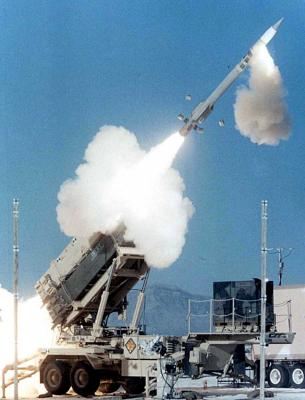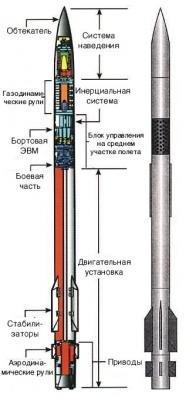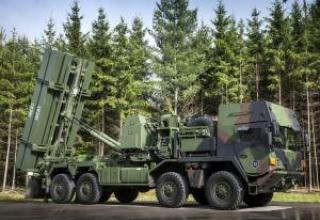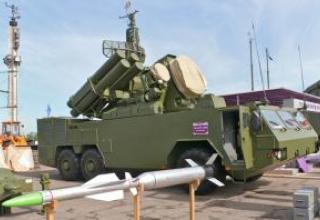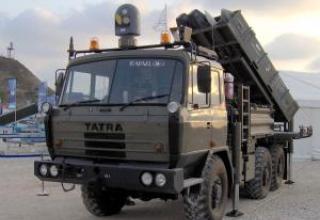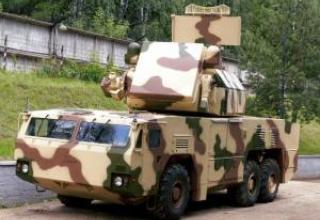The Patriot PAC-3 ("Patriot Advanced Capability-3") anti-aircraft missile system is one of the latest upgrade options for the famous Patriot air defense system and is designed to intercept warheads of tactical ballistic and cruise missiles, including those made using stealth technology.
In the process of creating this complex, two versions of the SAM system were developed on a competitive basis.
The first one was led by Ratheon and included the development of the MIM-109 advanced anti-aircraft missile with an active homing head, a shrapnel-array warhead and an engine length increased by 0.76 m in accordance with the APR (Advanced Tactical Patriot Program). The size and weight of the MIM-109 missile practically corresponded to the MIM-104 missile, and at the same time the available overloads of the new missile reached 40 g.
The second version proposed by Loral Vought Systems includes the use of a highly maneuverable direct hit ERINT (Extended Range Interceptor) missile in the Patriot PAC-3 complex.
In August 1994, a tender committee selected the second option and signed a contract with Loral Vought Systems worth $515 million for a duration of 47 months. The ERINT SSD was designed primarily as an interceptor for theater missile defense, in addition to the THAAD missile, the upper limit interceptor. The features of the ERINT-3 are its active radar and relatively short range - up to 15-20 km for ballistic purposes and up to 40-60 km for aerodynamic purposes. At the same time, to maximize the capabilities and minimize the cost of performing a combat mission, the RAS-3 battery includes missiles of earlier versions of PAC-2.
In July 2003, Lockheed Martin began work on the RAS-3 MSE program to improve RAS-3 missiles, including an increase in the size of their kill zone by one and a half times, as well as their adaptation for use in other air defense systems, including ships. For this purpose, the RAS-3 MSE is planned to be equipped with a new Aerojet 292 mm diameter 292 mm marching engine, to install a system of two-way communication between the missile and the Patriot air defense command post and to conduct a number of other activities. The first MSE test took place on May 21, 2008.
Composition:
The ERINT anti-missile is a single-stage solid fuel projectile made according to the normal aerodynamic scheme with small elongation wings and aerodynamic aileron rudders.
After launch, the missile, using an inertial guidance system, moves to the target acquisition point of the missile's active homing head. In this phase of the flight, aerodynamic rudders are used to control the missile, which also give the missile rotation relative to the longitudinal axis at a speed of 30 rpm. During the flight, the position of the target is continuously verified by ground-based means and corresponding correction signals are generated and transmitted to the missile. Before the active radar head captures the target, the nose fairing is reset and the radar antenna is pointed at the centre of the space occupied by the target. After capturing, the missile's rotation speed is increased to 180 rpm and its flight is further controlled by switching on small nose motors.
The main role of the ERINT rocket is to "reach" the upper boundary of the TBR and OTBR missed by one single (possibly paired) firing, without having to restart to analyze the results of the first firing due to the lack of space and time capabilities. Hence, the main task of ERINT SAM in the TVD missile defense system being created is destruction of a ballistic missile with various warheads with a high probability of combat load. This task is solved by high-precision guidance and kinetic defeat of the TBR as a result of direct hitting the combat load compartment at altitudes up to 15 km.
Limiting the maximum height of the kinetic defeat of the TBR to 15-20 kilometers allows the SAM to realize rather high aerodynamic overloads at an angle of attack of 10...14°. High precision guidance and direct hit in the warhead compartment are provided by a combination of accurate target information (due to the use of an active radar homing head of the millimeter range of waves, creating a "profile" of the target with the definition of the point of aim - the compartment of the combat load) and extremely short reaction time of the missile when working out the control commands (due to the use of torque gas-dynamic control).
In order to implement the torque gas-dynamic control, the ERINT rocket has an impulse propulsion system (IMU) installed in front of the mass center, which consists of 180 radially located single pulse microRTT (10 rings of 18 engines). With a total weight of 21.6 kg, the IMU is equipped with a fuel charge weighing 3.852 kg, which is 365 mm long and 255 mm in diameter.
During operation of the impulse engines located in the nose section of the rocket, the impact of their transversely flowing jets on the aerodynamic rudders located in the tail section leads to the appearance of significant disturbing moments. In particular, in this regard, in the homing area, where the IMU micro-DTT works, the rocket is given a forced rotation on the roll at a speed of 3 r / s, and the tail rudders are used only as ailerons. (The rotation of the rocket also promotes more economical use of micro-motors.)
Due to its much smaller size, the ERINT missile is housed in 16 pieces as part of the existing M901 launchers, with four missiles in each MIM-104 SAM container (see photos 1, 2, 3, 4). In order to maximize the capabilities of the Patriot RAS-3 SAM system, it is planned to combine the launchers with MIM-104 and ERINT missiles, which will increase the firepower of the battery by 75%.
Characteristics:
| The diameter of the rocket, mm | 254 |
| The length of the rocket, mm | 5010 |
| Wingspan, mm | 560 |
| Mass of the rocket, kg | 318 |
| Weight of combat unit, kg | 73 |
| Mass of striking tungsten fragment, kg | 0,214 |
| Target kill altitude, km | up to 20 |
| Total traction pulse, kgc-s | Around 15. |
| Maximum traction (average time of operation), kgf | 330 (220) |
| Working time (average), s | 0.023 |
| Body length/diameter, mm | 65/25 |
| Engine weight (without fuel), kg | 0.041 |
| Weight of fuel, kg | 0.0214 |
Testing:
During tests, ERINT missiles have repeatedly achieved direct hits to attacking ballistic missiles. During one of these tests, which took place on March 15, 1999, the second and third stages of the Minuteman-2 ICBM were destroyed by a direct hit.
According to the creators of the ERINT rocket, it is capable of destroying ballistic missiles with a range of up to 1000 km, including those equipped with chemical warheads.
Sources:
- Е.Г. Болотов, Б.Я. Мизрохи "Новое поколение зенитных управляемых ракет средней дальности", Специальный выпуск журнала "Полет" к 50-летию МКБ "Факел", 2003 г.
- Вестник ПВО
- Federation of American Scientists
